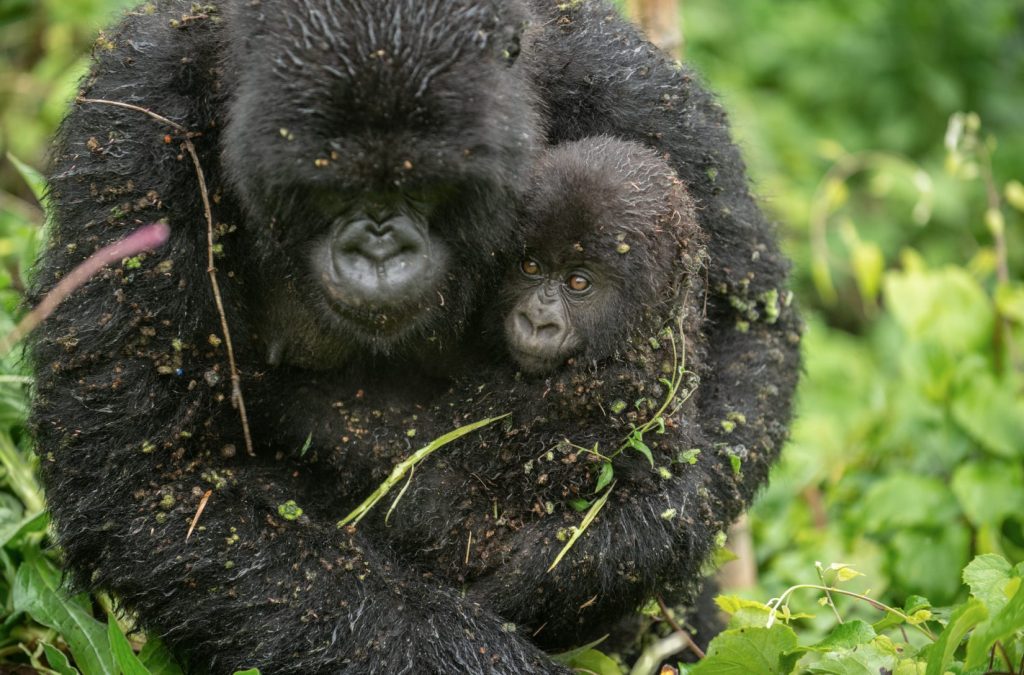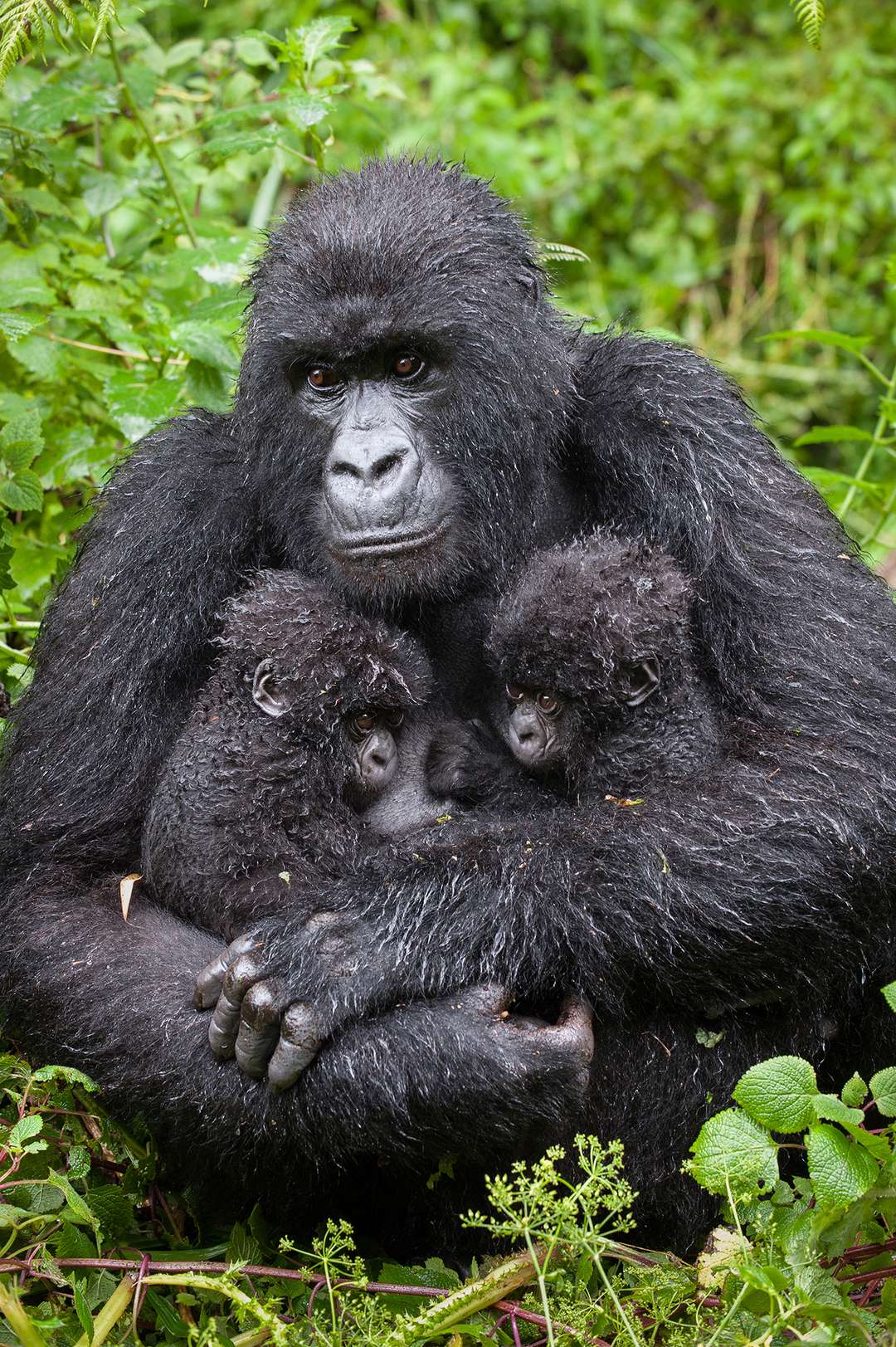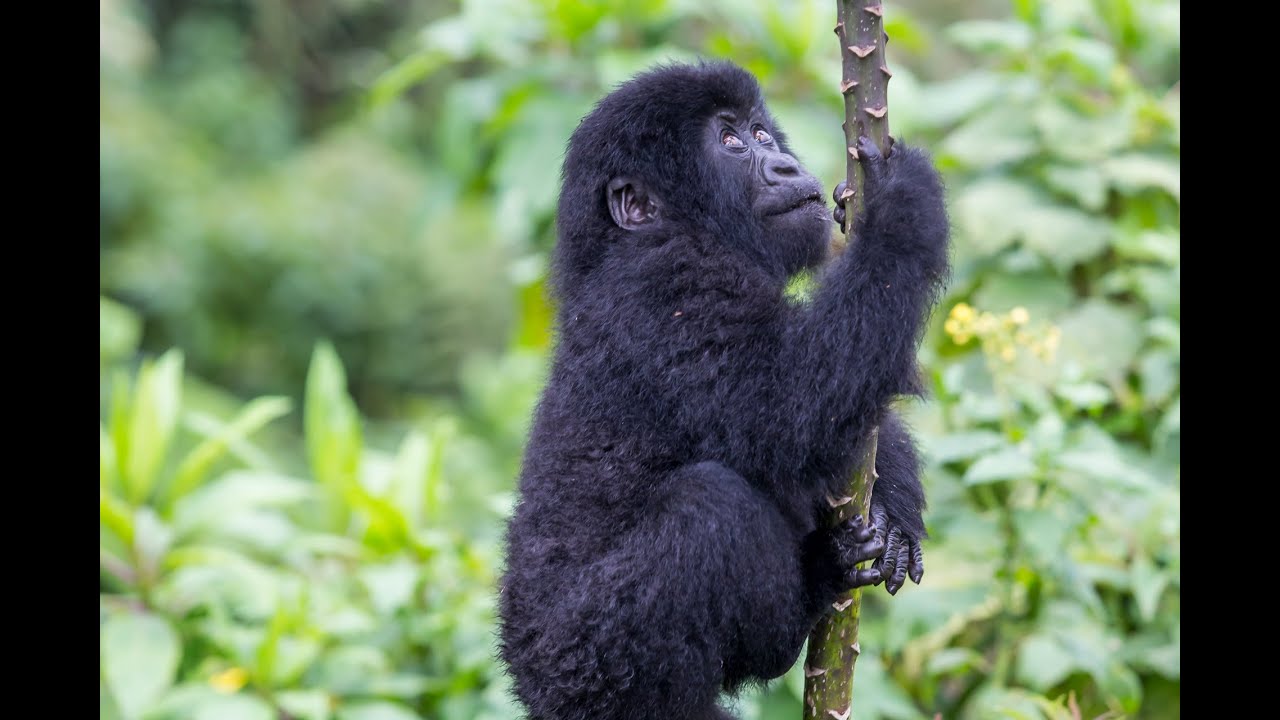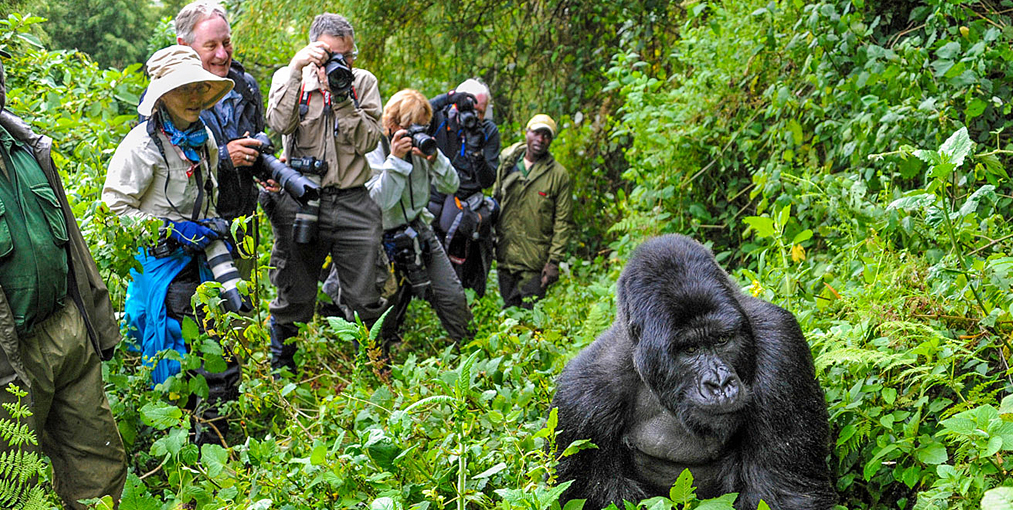- Written by: Brenda Bliss
- July 12, 2025
Baby Gorillas – Infants, Diet, Behaviour, and what they are called.
Baby Gorillas – Infants, Diet, Behavior, and the Quiet Pull They Have on Us
Baby gorillas look back at you with a gaze that feels unexpectedly direct. One moment you recognize something almost child-like in their eyes, the next you remember you are in the middle of a rainforest and nothing here belongs to you.
That tension—half mirror, half mystery—grabs people and keeps them staring a little longer than they planned.
If you listen to the guides in Uganda or Rwanda, you will hear variations of the same confession: visitors arrive for a once-in-a-lifetime trek, yet leave thinking about the infants far more than the enormous silverbacks they thought would dominate the story.
Below you will find what tiny gorillas eat, how they pass their days, where you can meet them, and small details that tend to hitch a ride in your memory long after the trip is over. I will slip in a few personal reactions, because leaving them out would make the account feel incomplete.
What Are Baby Gorillas Called?
Mostly, gorillas under three years are referred to as an infant. Once that birthday passes, the youngster earns the title juvenile until adolescence. A family group may be called a troop or band, although those words feel stiff when you are watching them rumble across a clearing in a flurry of dark fur and flailing limbs.
Mothers know their own without labels, and that is what matters to them. Researchers, on the other hand, need a clear way to track health records and family trees. They hold naming sessions that sometimes resemble small ceremonies. In Rwanda, the annual Kwita Izina event presents newly documented infants to local communities and global supporters alike.
Names can be given on the weather on the birth day, honour a respected elder, or echo a trait someone noticed in the youngster’s first minutes of observation.
I once met a tracker who spoke affectionately about a female called Umuryango, meaning “family” in Kinyarwanda, because she clung to her mother with unusual intensity, refusing to switch to the father’s back for nearly a year.
That small note, part observation, part story helped me remember her better than any field number ever could.

Baby Gorilla Being Groomed by its Mother
Growth in Slow Motion – Milestones You Might Notice
| Age range | Visible changes | Subtle shifts you only see if you watch a while |
| Birth to 3 months | Weighs about four pounds, clings to mother’s chest 24/7 | Fingers exploring fur texture, tiny vocal squeaks answered by soft grunts |
| 4 to 6 months | Begins looking outward more than inward, tries to swat flies | Experiments with balance, sways side to side before gripping tighter |
| 7 to 12 months | Crawls onto mother’s back, chews leaves and spits half of them out | Watches older siblings, copies the way they tug shoots from stems |
| 13 to 24 months | Walks short distances, plays chase with peers | Practices chest beats but produces little more than a dull thud |
| 25 to 36 months | Climbs low vines, nurses only for comfort | Tests boundaries—pushes into silverback’s space, retreats quickly |
If you film these phases and speed them up later, the transformation looks quick. In the field, it feels like gentle drip-feed progress.
A guide once told me he almost missed the moment a male infant stood on two feet for the first time because he was adjusting his camera lens; by the time he looked up, the youngster had dropped back to all fours as if embarrassed by his own experiment.
Suggested Safari Itineraries
4 Days Rwanda Gorilla Tour and Golden Monkey Trekking
$ 2500
per personBaby Gorilla Diet – From Milk to Leaves and Back Again
For roughly the first half-year an infant lives on nothing but mother’s milk. Watch closely and you will see a rhythmic swallow, pause, swallow pattern, the jaw working in tiny pulses while a hand kneads the fur like a baker testing dough.
Around month seven the little one begins to mouth leaves, sometimes pulling a face that reads as mild disappointment. It takes practice to enjoy the bitterness of wild celery or the fibrous skin of certain creepers.
By nine months the menu widens:
- Tender leaves torn from shrubs at gorilla eye-level.
- Soft fruits—wild figs are a favourite, though supply can be unpredictable.
- Bark shavings stripped from thin branches. Unspectacular to us, but loaded with sodium the forest diet can lack.
- Occasional flowers plucked quickly before bees protest.
Nursing does not end abruptly. It tapers. Around two years, a youngster might dash back to the mother for a thirty-second sip, more reassurance than nutrition. At three or four, the practice fades, replaced by full participation in group foraging.

How Baby Gorillas Spend Their Days
Imagine a child-care centre without walls, adult supervision that feels permissive rather than strict, and a floor made of tangled vines. That is a fair starting point. Infants behave like toddlers anywhere: easily fascinated, equally easily alarmed, determined in pulses, then suddenly asleep. A typical cycle unfolds like this:
- Early morning: the family wakes in the nested beds built the previous evening. Mothers groom infants, removing leaves and mites. The forest is cool, mist hanging low.
- Mid-morning forage: everyone spreads through a patch of vegetation. Infants ride on backs or experiment with unsupported walking, stopping to chew stems or taste loose dirt.
- Play block: the adults settle to digest. Younger members wrestle, chase, steal stems, and practice chest beats that sound more like muffled pats. Baby gorilla laughter is soft, breathy chuckles floats across the clearing.
- Siesta: heat rises. Bodies sprawl in shade. You might catch an infant’s eyes drooping while still chewing on a leaf.
- Second forage – movement resumes, driven mainly by the silverback or a confident adult female who decides the patch is picked over.
- Dusk nesting: each gorilla bends branches into a fresh bed. Infants help in clumsy ways, flinging twigs until a parent smooths the shape.
During a trek I noticed one infant insist on climbing a sapling no thicker than my wrist. Halfway up, it bent. He froze, clinging, eyes wide, then slid down in slow motion, landing in a surprised heap. His mother glanced over, offered no comfort, and continued eating. A minute later he tried again, grip firmer, expression steeled. The adults seem to grant wide room for trial and error, stepping in only when real danger looms.
Communication – Small Voices in a Big Forest
Adult gorillas rely on chest beats, hoots, and low rumbles. Infants add a lighter register:
- Whimpers when they lose sight of the mother.
- High-pitched squeals if a playmate bites too hard. n
- Soft clicking sounds during calm grooming sessions.
Observers sometimes describe the clicks as a conversational murmur that parallels the adults’ deeper rumbles. No catalogue fully captures the nuance yet, though acoustic studies are underway. I found the mix oddly soothing—it reminded me of a busy café, where overlapping voices melt into one background hum-like wash (only quieter, without espresso machines).

Baby Gorilla Playing on a tree Branch
Where You Can See baby gorillas?
Strict rules keep the experience safe for both primates and visitors. Group size tops out at eight people. Masks reduce the risk of transmitting human viruses. Time on site rarely exceeds one hour, measured with surprising precision.
Mountain gorilla Destinations
- Bwindi Impenetrable National Park, Uganda. The name sounds foreboding, yet trails are well marked, and the understorey opens suddenly to reveal families feeding on giant celery.
- Volcanoes National Park, Rwanda. The forest here climbs volcano slopes, mist rising in ribbons as the sun warms the canopy. Infants often appear around bamboo thickets.
- Virunga National Park, Democratic Republic of Congo. Political stability can be fragile, yet when conditions permit, this park delivers encounters few places match.
Western lowland habitat
- Odzala-Kokoua – Republic of Congo. Swamp forests demand patience. Guides paddle you along narrow channels where vegetation brushes both shoulders.
- Dzanga-Sangha Reserve – Central African Republic. A platform at Bai Hokou offers a chance to watch families feeding in mineral-rich clearings. The infants dart between legs like children darting through market crowds.
Prepare for a trek of two to six hours, often on steep slopes or through marsh that clings to your boots. Moments of silence can stretch, broken only by your own breathing. Then a branch shifts, a dark face emerges, and the forest feels smaller.
Best Times To Trek
| Season | Months | Pros | Possible wrinkles |
| Dry | June to September and December to February | Firmer trails, lighter clothing, easier photography | Dust on exposed slopes, higher visitor demand |
| Rainy | March to May and October to November | Lush foliage, fewer tourists, soft filtered light | Mud, steeper airfares occasionally, longer search times |
I visited in April once and found the drizzle lent the forest a kind of hush. Every leaf glistened, footsteps softened, and when the guide pointed out an infant perched on a bent vine, the scene felt oddly theatrical, as if stage lighting had been turned down for effect.
Recommended Safaris
5 Day Rwanda Gorilla Trekking with Musanze Caves Exploration
$ 3299
per personFun Facts That Stick
- Newborn gorillas often grip so tightly that researchers joke you could hang them from a branch without fear of a drop (they do not test this, of course).
- Weight gain in the first year can triple the birth figure, yet the infant still looks small when dwarfed by a silverback pushing four hundred pounds.
- Gorillas rarely swim, but infants love dipping hands in puddles, splashing with clear delight until a parent herds them away.
- Play bouts between youngsters can run for half an hour without pause, punctuated by quick naps where they collapse shoulder to shoulder, breathing heavily but smiling in their own gorilla way.
- Conservation successes are fragile. A single respiratory outbreak could undo years of population gains, which is why visitors must stand seven metres back and whisper.
Tips for Travellers Who Hope to Meet Them
- Train your fitness. Steep paths feel longer at altitude. A slow, steady pace helps.
- Wear neutral tones. Bright colours can unsettle wildlife. Greens, browns, and muted greys blend in and are the most recommended.
- Pack lightweight rain gear. Even in dry months a cloud burst can arrive with little warning.
- Carry a reusable water bottle and drink frequently. Dehydration sneaks up.
- Listen to the guides. They read subtle shifts in gorilla mood. If they signal to step back, do so without hesitation.
- Put the camera down now and then. A full memory card is nice. A direct, unfiltered moment is better.
Conservation
Every infant alive today represents decades of work: anti-poaching patrols, community revenue sharing, veterinary interventions, and careful tourism management. Fees paid by visitors help fund these measures, yet the equation remains delicate. One season of political unrest can slash permit sales, cutting budgets overnight. A souvenir purchased from an illegal charcoal seller feeds the same chain that threatens the forest the gorillas need.
I once asked a ranger what keeps him motivated during long patrols. He paused, glanced toward a nearby mother and her clinging infant, and said, “We promised her parents we would watch her. Now we make that promise to her.” It sounded both practical and deeply personal all at once.
Conclusion
Just spend an hour near a baby gorilla and you will collect both in abundance: the measurable growth rates, the names tied to local history, the strict sixty-minute visitor window, plus the intangible jolt when an infant tilts its head and seems to weigh your presence.
Replay the way a mother shifted her weight so a curious youngster could climb higher. Recall the soft hiss of rain sliding through leaves above your group. Hold on to the realization that the smallest creatures in that clearing already carry the future of an entire species on their narrow shoulders.
Those memories, paired with the decisions you make afterward—choosing coffee grown outside gorilla habitat, supporting conservation funds, sharing stories that move friends to care—extend the experience beyond the forest. And perhaps one day, another traveler will meet a youngster who bears a name chosen because you helped keep that naming ceremony alive.

Ready for your ultimate wildlife experience?
Chat with us, our team is always here to help!
You may also like …

Got any questions
about traveling to Uganda?
Get in touch.








